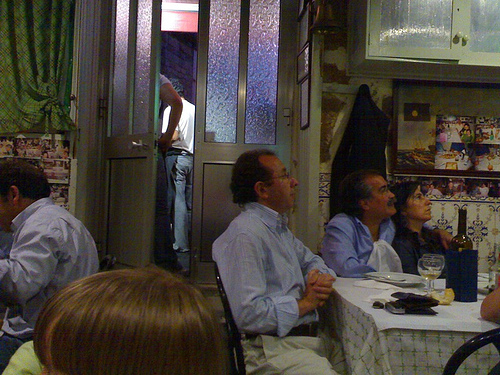After 12 hours of travel (with lots of standing still), we’ve arrived in Copenhagen, and are happily installed in the little apartment we’re renting until mid-June. We were up at 6:00 a.m. in Portugal, in a cab to the airport at 7:00 a.m., en route to London on Ryanair at 9:25 a.m. (on time departure; arrived 15 minutes early), had a 6 hour layover at London Stansted, and then took the 6:15 p.m. easyJet flight to Copenhagen, arriving here at 9:00 p.m. By the time we gathered our luggage, took the train downtown, and walked over here, it was nigh on 10:00 p.m.
Peter, our gracious host, gave us the lowdown on the apartment — which keys do what, how to unlock the bicycles, how to start the stove — most of which I’m sure we’ll have completely forgotten come morning. We’re right in the thick of urban Copenhagen, which is exactly what we wanted. And there are toys here, and a playground and rumours of excellent hot chocolate, so Oliver is happy too.
Lots more tales to tell, but exhaustion getting the better of me, so must sleep.
Just because my Dad assumed otherwise, I’ll mention that all of the photos I’ve taken here in Portugal I’ve taken with my Nokia N70 camera phone (or is it a phone camera?). I’m very happy with the result, especially compared with the horrible photos my old T610 used to take.
As I’ve used the N70 to take photos, check email, navigate maps, set my Plazes location, take notes, look up phone numbers and, oh, make telephone calls, I’m more and more convinced of the “one integrated device is best” school of gizmology.
On our way into Leça da Palmeira two weeks ago, the man who was driving us to our home here pointed out the fish restaurant on the corner. “Good fish there,” he said. So on the second night here, we tried to go there for dinner. “No tables,” we were told.
So we held back, biding our time. Every day on our way to the Metro, we waved hello to the owner, tending to his outdoor fish grill. And yesterday Catherine stopped in first thing in the morning to inquire about a table for tonight and found, to our pleasure, that they had room.
“On the corner,” in this case means about 35 steps from the house we are staying in. You could not eat more “locally” if you tried. And the smell of grilled fish, as a result, was ever-present during our stay here. We were very much looking forward to this meal.
So at the appointed time — 8:00 p.m. tonight — we were ushered to a table for three in the compact space, and told to just sit back and enjoy the ride: everything would be a surprise.
We started off with a plate of giant mussels. Catherine says “not as good as PEI mussels” but I wouldn’t know, as they were my first mussels. Not something I’d have for breakfast, but if you imagine the sea you do okay.
Next, a plate of sardines. I’d always envisioned sardines as coming in a can packed in oil; these were fresh sardines, lightly salted and fresh from the grill. Once I got over the bone navigation issues (remember, I’m a guy raised on Captain Highliner fish sticks), they were fantastic.
The main course came next — a large platter piled high with various fish. We had no idea what we were eating — Catherine, who knows about these things, said “white fish of some sort” — but it was all good.

We finished up with a dessert of chocolate cake glazed with strawberry jam (“made by my mother,” our waiter told us) and a special shot of some powerful Slivovic-like drink that knocked my socks off.
As the evening went on, more and more customers packed into the small space, and we garnered as much entertainment from watching the service ballet around us all as anything else.

At the end of the evening — 40 EUR for three of us — Oliver shook the waiter’s hand, and the chef’s, and the hands of many of our fellow diners. And then we stole off for the long 35 step walk home.
This, I think, is how restaurants are supposed to work.
I’d tell you the name of the place if I knew it, but I don’t. Walk over the bridge from Matosinhos, take a left at the roundabout, then your first left back towards the river. You’ll see the place just down the hill on the left; look for the grill outside, and the smiling chef.
We’re off at the crack of dawn tomorrow morning flying on Ryanair from Porto to London Stansted, then after a 6 hour layover, from Stansted to Copenhagen on easyJet. Forecast high for tomorrow in Porto is 25 degrees C; for Copenhagen it’s 12 degrees C. In other words, Catherine is going to need to get herself a new spring coat pretty soon after we arrive there.
Porto has been wonderful, and we’re certain to return someday soon, as we feel like we’ve only scratched the surface of its wonders.
We spent our last day here rambling around Leça da Palmeira, going out to the beach and having a bite to eat, and getting all packed up. Tonight we’re going out for dinner to the fish restaurant that’s a stones throw from our house — the restaurant we’ve been walking by for almost two weeks and marveling at the smells of fresh fish on the grill.
If Catherine’s symbolic representations of taxis and airports and 7 a.m. to the woman at the corner store made enough sense, a cab will arrive here tomorrow morning to carry us off north.
Look out Copenhagen, here we come…
There has been discussion of late on Prince Edward Island about banning students from using mobile telephones in school; the discussion originated with the PEI Home and School Federation. The rationale? President Wendy Macdonald was quoted by the CBC as explaining:
…parents on P.E.I. have said they’re not comfortable with how quickly young people are using the latest technologies to change the way they communicate with one another.
When I first heard of this decision, I found myself in general agreement — “kids should be concentrating on learning about Magellan and quadrilateral triangles in school, not sending SMS messages to each other,” I said to myself.
But I’ve been thinking about this a lot, especially since we arrived in mobile phone-drenched Portugal, and I now think the decision is wrong-headed.
While parents may be “not comfortable” with the pace of new technologies — and are parents ever comfortable with the pace of new technologies? — these new technologies are here, they’re being used, and they’re being used in places that aren’t Prince Edward Island to a much greater extent than they are on PEI.
Here in Europe you can bank with your mobile, pay parking tickets with your mobile, get travel information, check your email, watch television and edit movies. Mobile devices are a part of everyday life here, and absolutely everyone carries one: I’ve seen them in the hands of kids in grade 7 and in the hands of seniors.
On a visit to the art gallery in Porto last week we saw high school students taking digital pictures of art with their mobile phones. On the train up to Régua this week we sat beside a group of older woman, many of whom were checking their mobiles for text messages from their seats.
If the experience here is any guide — and I’m pretty sure it is — the future is going to involve some sort of mobile device in the hands of everyone most of the time.
While we can debate the merits of this like we debated whether or not the coming of the pocket calculator would result in kids who couldn’t add or subtract, there is an inevitability here that makes it seem rather short-sighted to try and make the future go away because you’re “not comfortable” with it.
Surely if schools have any role at all, it is to shape and guide the use of new technologies. Taking the “prohibition” tack never, ever works with kids; you only have to look at underage binge drinking to understand what pretending to hide something away in a box does for educating responsibility.
So rather than trying to stamp mobile phones out of the classroom, why not make sure that every child has access to one, regardless of income. Build aspects of the curriculum around mobile devices, foster community, harness the power of ubiquitous network access, take advantage of the fact that kids are attracted to the technology to channel its use in positive ways.
I’m pretty sure that whenever parents say that they’re “not comfortable with how quickly young people are using the latest technologies” this should be a call to schools to grab onto whatever the latest technology is and allow their students to fly with it.
In early may, in a rush to get all the bills paid, I mistakenly used my Metro Credit Union web banking system to pay a bill that didn’t exist — I paid down $3000 on a credit card that I’d cancelled earlier in the year. This was completely operator error on my part: I should have removed the “payee” from my setup once I’d cancelled the card, and I didn’t. The result was that I checked the wrong “VISA” line when I went to pay the bill.
And it was Sunday.
I tried calling the Internet technical support line and, although they were kind, they couldn’t help (it’s probably a Good Thing that technicians can’t move money).
They suggested a call “TelPay” which is the agency that actually routes online bill payments through to local credit unions for handling (the great secret of the “online banking” universe is that the back-end is still very, very manual). TelPay’s voicemail answered and I left a message; they called me back and left a message for me a few hours later telling me that there was nothing they could do to help.
So I sent email to the ever-helpful Doug Bridges at Metro Credit Union. And I left him a voicemail. And I left a general voicemail there too, just in case Doug was on vacation or out of the office.
Monday morning, bless their hearts, Metro were all over the issue, and managed to get the right messages to the right places to stop the bill payment train from running (I couldn’t imagine what trying to get $3000 back out of a closed VISA account would be like).
By the time all was said and done, it took 18 days to get the money back into my business account proving that, even with the best intentions of all involved, it still takes time to undo stupid mistakes.
I don’t fault Metro for any of this — as I said, it was operator error that caused the problem. And Doug stayed in touch with me through the undo process. But it seems to me that, going forward, it might make general sense to build customer-driven undo features into web banking systems; surely I’m not the only one clicking in the wrong place.
Another lesson learned.
It seems that Flickr has melted down; as a result, you can expect “this image not available” graphics to appear various places here until things are fixed there.
Oliver was very excited to find that Blue’s Clues exists in Portugal, albeit with a host named Duarte (I think) and not Steve (or Joe):

One our way down into Porto this morning for our train out to Régua, we were nabbed by the transit cops.
The Porto Metro system, like many these days, works on the honour system — you buy and validate your ticket on your own, and there are no gates to pass through, you just walk on. The check against abuse is a team of roving ticket checkers who carry hand-held computers that can check to see if the ticket you bought (assuming you bought a ticket in the first place!) is valid.
Our tickets weren’t valid.
As it happens, we got nabbed just as our stop was coming up, so when we arrived at Trindade station we were accompanied by the Metro Cops. They were actually quite pleasant — no shackles or take-downs, etc. — and when they realized we were non-Portuguese, the gloves came on in full and they were super-nice to us.
The error of our ways was simple: we’d been working under the assumption that when you purchased a ticket, you determined the number of “zones” you needed to purchase by counting the number of zone boundaries you were going to cross. We started in C3, and were traveling through C2 to C1, so always reasoned that this would require a two zone (or “Z2”) ticket.
It doesn’t.
You count the total number of zones that you’ll travel from, through and into to calculate your ticket needs: so a trip from C3 through C2 to C1 is a three zone ticket.
Oops.
Fortunately we were taken pity on (we didn’t mention a week and a half of previous offenses), and let off with a simple purchase of the additional zones required.
There was a subsidiary issue of needing a ticket for Oliver too — ignorance again — but that again was let off with a simple ticket purchase.
In our bleary morning coffee-less fog, this all seemed a little bit overwhelming, but as the day wore on we came to appreciate how lucky we were to encounter such friendly enforcers. Had the situation gone differently, we might have spent the day cooling our heels in Transit Prison rather than floating down the Douro.
Lesson learned.
Given that the spark of the germ of the idea that got us here to Porto was reading Cork Boat by John Pollack, a necessary component of this trip was to experience Douro River up close.
So this morning the alarm went off at 6:15 a.m., we were out of the house by 7:00 a.m., and at the São Bento Station by 8:00 a.m. for departure to Régua, about 2 hours upriver from Porto, and the departure point for our cruise down-river. The day was perfect: crisp and sunny with just a little wind.
We were sailing with Douro Azul, one of the major operators on the river, and our 42 EUR ticket (1/2 price for Oliver) included train transportation up and cruise back down, with 3-course lunch on the boat included. It was worth every penny.
Before I found Cork Boat in the used books section last year, I’d never heard of the Douro river: Danube, Nile, Vltava yes, but never a word about the Douro. This is not surprising, of course, given that for many years I’d confused Puerto Rico with Portugal (yes, I am an idiot; and it kind of makes it hard to tear a strip out of others for that whole Slovenia - Slovakia confusion).
I’m happy to say that not only have I come to understand the unique attractions of Portugal, but now that I’ve sailed down the Douro, I’ve come to appreciate it as one of the world’s great rivers. I took a gazillion photos (warning: many photos of shore from river, locks, etc.), but none can really do justice to the majesty of this body of water. Like the Grand Canyon, it’s something that you simply can’t take a picture of; you gotta be there yourself to understand.
Although the cruise down-river took 6 hours, it didn’t feel long at all, as there was always something to catch the eye around the next corner. If you are ever anywhere near the Douro, I heartily recommend experiencing it firsthand.
We arrived back in Vila Nova de Gaia quay (across the river from Porto) around 6:00 p.m., and feeling the tickle of being famished, we opted to eat right on the wharf at an Indian restaurant called Real Indiana. Much to our surprise (we expected Pizza Hut style Indian food), the food was excellent, and the service stellar (anyone who gives Oliver a Kinder Surprise Egg on the way out deserves an award in my books).
When dinner was over we walked back into Porto over the Ponte Luiz I, up the hill back to São Bento Station, and caught the Metro home.
It was an excellent day.
 I am
I am